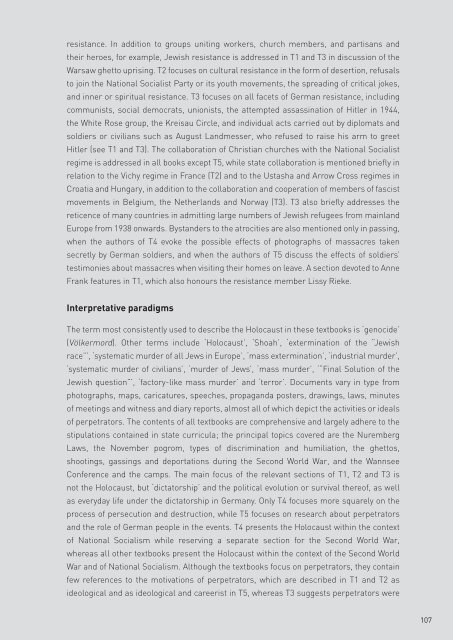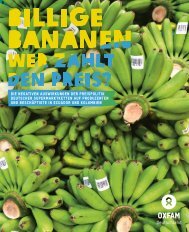228776e
228776e
228776e
Create successful ePaper yourself
Turn your PDF publications into a flip-book with our unique Google optimized e-Paper software.
esistance. In addition to groups uniting workers, church members, and partisans and<br />
their heroes, for example, Jewish resistance is addressed in T1 and T3 in discussion of the<br />
Warsaw ghetto uprising. T2 focuses on cultural resistance in the form of desertion, refusals<br />
to join the National Socialist Party or its youth movements, the spreading of critical jokes,<br />
and inner or spiritual resistance. T3 focuses on all facets of German resistance, including<br />
communists, social democrats, unionists, the attempted assassination of Hitler in 1944,<br />
the White Rose group, the Kreisau Circle, and individual acts carried out by diplomats and<br />
soldiers or civilians such as August Landmesser, who refused to raise his arm to greet<br />
Hitler (see T1 and T3). The collaboration of Christian churches with the National Socialist<br />
regime is addressed in all books except T5, while state collaboration is mentioned briefly in<br />
relation to the Vichy regime in France (T2) and to the Ustasha and Arrow Cross regimes in<br />
Croatia and Hungary, in addition to the collaboration and cooperation of members of fascist<br />
movements in Belgium, the Netherlands and Norway (T3). T3 also briefly addresses the<br />
reticence of many countries in admitting large numbers of Jewish refugees from mainland<br />
Europe from 1938 onwards. Bystanders to the atrocities are also mentioned only in passing,<br />
when the authors of T4 evoke the possible effects of photographs of massacres taken<br />
secretly by German soldiers, and when the authors of T5 discuss the effects of soldiers’<br />
testimonies about massacres when visiting their homes on leave. A section devoted to Anne<br />
Frank features in T1, which also honours the resistance member Lissy Rieke.<br />
Interpretative paradigms<br />
The term most consistently used to describe the Holocaust in these textbooks is ‘genocide’<br />
(Völkermord). Other terms include ‘Holocaust’, ‘Shoah’, ‘extermination of the “Jewish<br />
race”’, ‘systematic murder of all Jews in Europe’, ‘mass extermination’, ‘industrial murder’,<br />
‘systematic murder of civilians’, ‘murder of Jews’, ‘mass murder’, ‘“Final Solution of the<br />
Jewish question”’, ‘factory-like mass murder’ and ‘terror’. Documents vary in type from<br />
photographs, maps, caricatures, speeches, propaganda posters, drawings, laws, minutes<br />
of meetings and witness and diary reports, almost all of which depict the activities or ideals<br />
of perpetrators. The contents of all textbooks are comprehensive and largely adhere to the<br />
stipulations contained in state curricula; the principal topics covered are the Nuremberg<br />
Laws, the November pogrom, types of discrimination and humiliation, the ghettos,<br />
shootings, gassings and deportations during the Second World War, and the Wannsee<br />
Conference and the camps. The main focus of the relevant sections of T1, T2 and T3 is<br />
not the Holocaust, but ‘dictatorship’ and the political evolution or survival thereof, as well<br />
as everyday life under the dictatorship in Germany. Only T4 focuses more squarely on the<br />
process of persecution and destruction, while T5 focuses on research about perpetrators<br />
and the role of German people in the events. T4 presents the Holocaust within the context<br />
of National Socialism while reserving a separate section for the Second World War,<br />
whereas all other textbooks present the Holocaust within the context of the Second World<br />
War and of National Socialism. Although the textbooks focus on perpetrators, they contain<br />
few references to the motivations of perpetrators, which are described in T1 and T2 as<br />
ideological and as ideological and careerist in T5, whereas T3 suggests perpetrators were<br />
107




